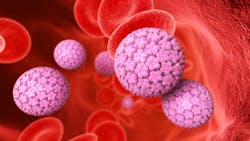The important role dental professionals play in educating patients about HPV prevention
With the growing prevalence of oral HPV, Dr. Randi Tillman stresses that is critical for dental professionals to understand what they should look for in their patients, and how they can play a role in advocating for oral cancer prevention.
Editor's note: This article originally appeared in Breakthrough Clinical, a clinical specialties newsletter from Dental Economics and DentistryIQ. To subscribe, visit dentistryiq.com/subscribe.
THERE HAS BEEN A GREAT DEAL OF DISCUSSION on the topic of human papillomavirus (HPV) and the role that dental professionals play in raising awareness and advocating for preventive care. A strong need exists for dental professionals to become knowledgeable about the topic of HPV, specifically oral HPV, and work with their patients to educate them about the impact HPV can have on oral health as well as its implications on overall health and well-being.
It is somewhat alarming to note that HPV oral cancer has surpassed cervical cancer as the most common type of HPV. While it is recognized that HPV is one of the most prevalent sexually transmitted diseases, it is not as well known that oral HPV is the leading cause of oral and oropharyngeal cancers in the United States. (1) A patient with oral HPV is 20 times more likely than his or her noninfected peers to develop oropharyngeal cancer. (2) As a result, it is imperative that dentists and dental hygienists talk with their patients and their younger patients’ parents about HPV prevention. The HPV vaccine is reliable, and it has been thoroughly tested. Dental professionals not only can identify the disease in its earliest stages, but they also have the opportunity to educate their at-risk patients. (3)
The growing issue of oral HPV
According to Our World in Data, oral cancer is the ninth most prevalent cancer, with 1.39 million people affected in 2016. (4) One of the leading causes of oropharyngeal cancers in the United States is HPV. In fact, HPV is thought to cause 70% of oropharyngeal cancers, primarily infecting the tonsils, tonsillar crypt, the base of the tongue, and occasionally the front of the mouth. A growing number of people are contracting oral HPV—currently 10% of men and 3.6% of all women in the US have HPV. (1)
Generally, oral HPV is caused from skin-to-skin genital contact, most often during oral sex. Men are four times more likely than women to get HPV-related mouth and throat cancer. Although the risk of these cancers is increasing for both sexes, it is rising at a much faster rate in males ages 35–55. (1) As oral cancers caused by HPV become more prevalent, it is increasingly important for dental professionals to understand what they should look for, and how they can play a role in advocating for prevention.
What does the average person with oral cancer look like?
Most oral cancer patients are 55 years old or older, and 80% use tobacco or are heavy drinkers (almost 70%). (5) However, the individual profiles change dramatically with oral cancers linked to HPV. These individuals are generally healthy and typically are nonsmokers and may even be nondrinkers. (5) It is for this reason that the initial signs of HPV and/or oral cancer are often missed in this seemingly healthy population.
What dentists should be looking for
It is widely accepted that the identification of oral disease is within the clinical purview of the dentist and the dental hygienist. Therefore, it is of importance that dentists and hygienists understand the signs and symptoms of HPV as it presents in the oral cavity. It is unfortunate that oral HPV symptoms are painless and often go unnoticed. As a result, dentists and dental hygienists may be the first to detect an unusual-looking lesion in the oral cavity when patients are in the office for routine checkups. Identifying these (often) painless lesions may be lifesaving for patients.
Listed below are some signs and symptoms a patient may exhibit that would prompt a clinician to consider a diagnosis of HPV: (1)
- A swollen, painless tonsil
- An ulcer or sore that’s been present for two to three weeks
- A red, white, or black discoloration on the soft tissues in the mouth
- Difficult or painful swallowing/chewing
- Numb feeling in the mouth or lips
- A persistent cough
- An earache lasting for several days
If your patient mentions any of the above signs, or if you see any of these signs, check to see if there’s a painless lump on the outside of the neck. If there is one, ask if the patient knows how long it has been there. (1)
Educating patients about oral HPV prevention
In 2016, the World Dental Federation changed the definition of oral health to:
Oral health is multifaceted and includes the ability to speak, smile, smell, taste, touch, chew, swallow, and convey a range of emotions through facial expressions with confidence and without pain, discomfort, and disease of the craniofacial complex. (6)
Since that time, and even before, there has been a great deal of discussion and research about the dental-medical connection. The mouth is indeed part of the body, and dental professionals need to recognize that by screening for oral cancer and HPV, they have the potential to impact the patient’s overall health. (7)
The Centers for Disease Control and Prevention (CDC) recommends 11- to 12-year-old children receive two doses of the HPV vaccine, with the second dose given six to 12 months after the first dose. (8) Dentists are encouraged to talk with parents who have children ages 11 to 12, suggesting that they speak to their primary health-care provider about getting the HPV vaccination. According to the Infectious Diseases Society of America, only about 16% of US adolescents have been fully vaccinated against HPV by the time they turn 13, despite the recommendations. (9) The dental profession has the opportunity to make an important impact on this disappointing rate of compliance.
How dentists can educate patients
While it can be an uncomfortable discussion, dentists play an important role and should talk to patients and/or their parents about how to best prevent oral HPV. Oral health-care professionals should take every opportunity to advocate that their patients receive the HPV vaccination and highlight the relationship between HPV and oral cancer. For example, during routine checkups, dentists should monitor for suspicious lesions that may be oral HPV and provide proper counsel if they suspect a patient has the disease.
Dentists ought to consider having educational information, such as brochures about the HPV vaccination, available to their patients in both treatment and reception rooms. They should also consider proactively giving educational materials to at-risk patients and/or their parents after checkups. It is important to note the CDC recommends that females through age 26 and males through age 21 get the vaccine if they have not already done so. (10)
Promoting strong preventive oral health may also be top of mind for dental professionals when discussing oral HPV with their patients. According to a study from the American Association for Cancer Research, poor oral health, including gum disease, was found to be an independent risk factor for the oral HPV infection. (11) The study, which focused on men and women ages 30–69 years old, found that those who reported poor oral health had a 56% higher prevalence of oral HPV infection than those in good oral health. The study concluded, “Given that oral hygiene is fundamental for oral health and that it is modifiable, public health interventions may aim to promote oral hygiene and oral health as additional preventive measures for HPV-related oral cancers.”(12)
It is of importance that dental professionals continue to remind their patients about the importance of good oral home care and routine dental checkups. This is not only for the sake of their teeth, but for the sake of their overall health and well-being, in addition to preventing the risk of serious oral conditions such as HPV.
Article disclaimer: The Guardian Life Insurance Company of America, New York, New York. The material discussed is meant for general informational purposes only and is not to be construed as advice. Although the information has been gathered from sources believed to be reliable, please note that individual situations can vary. Therefore, the information should be relied upon only when coordinated with individual professional advice. This material contains the current opinions of the author, but not necessarily those of Guardian or its subsidiaries, and such opinions are subject to change without notice. 2019-75260 (02/21)
References
1. HPV/oral cancer facts. The Oral Cancer Foundation website. https://oralcancerfoundation.org/understanding/hpv/hpv-oral-cancer-facts/. Accessed January 15, 2019.
2. Rindal DB, Gilbert G, Carcelén C, et al. Feasibility and acceptance of oral human papillomavirus detection in the dental office: Results from the National Dental Practice-Based Research Network. J Am Dent Assoc. 2019;150(2):130-139.e4. doi:10.1016/j.adaj.2018.10.022. https://jada.ada.org/article/S0002-8177(18)30762-1/fulltext. Accessed February 19, 2019.
3. The American Cancer Society medical and editorial content team. HPV and cancer. Cancers linked to HPV infection. Mouth and throat cancer. The American Cancer Society website. https://www.cancer.org/cancer/cancer-causes/infectious-agents/hpv/hpv-and-cancer-info.html. Updated October 9, 2017. Accessed March 20, 2019.
4. Researchers from the University of Oxford. Number of people with cancer by type, World, 2016. Our World in Data website. Collaboration between University of Oxford and Global Change Data Lab. https://ourworldindata.org/grapher/number-of-people-with-cancer-by-type. Accessed January 22, 2019.
5. The American Cancer Society medical and editorial content team. Risk factors for oral cavity and oropharyngeal cancers. American Cancer Society website. https://www.cancer.org/cancer/oral-cavity-and-oropharyngeal-cancer/causes-risks-prevention/risk-factors.html. Updated March 9, 2018. Accessed January 22, 2019.
6. Glick M, Williams DM, Kleinman DV, Vujicic M, Watt RG, Weyant RJ. A new definition of oral health developed by the FDI World Dental Federation opens the door to a universal definition of oral health. Int Dent J. 2016;66(6):322-324. doi:10.1111/idj.12294.)
7. White paper: The future of dentistry. The Guardian Life Insurance Company of America. https://www.guardiananytime.com/gafd/wps/portal/fdhome/brokers/products-and-coverage/dental-insurance/future-of-dentistry. Accessed February 6, 2018.
8. HPV and oropharyngeal cancer. Division of Cancer Prevention and Control, Centers for Disease Control and Prevention website. https://www.cdc.gov/cancer/hpv/basic_info/hpv_oropharyngeal.htm. Updated March 14, 2018. Accessed January 15, 2019.
9. HPV vaccination rates remain critically low among younger adolescents in the U.S. Infectious Diseases Society of America. ScienceDaily. https://www.sciencedaily.com/releases/2019/01/190117090506.htm. Published January 17, 2019. Accessed January 22, 2019.
10. HPV vaccine information for clinicians. HPV vaccine recommendations. Centers for Disease Control and Prevention. https://www.cdc.gov/hpv/hcp/need-to-know.pdf. Updated May 2018. Accessed March 20, 2019.
11. Study examines oral health, HPV infection. Study published August 23, 2018, in American Association for Cancer ResearchJournal. Article by the American Dental Association. Colgate-Palmolive Company website. https://www.colgate.com/en-us/oral-health/conditions/hiv-aids-and-stds/ada-08-study-examines-oral-health-hpvi-infection. Published 2019. Accessed January 16, 2019.
12. Bui TC, Markham CM, Ross MW, Mullen PD. Examining the association between oral health and oral HPV infection. Cancer Prev Res. 2013;6(9):917-924. doi:10.1158/1940-6207.CAPR-13-0081. http://cancerpreventionresearch.aacrjournals.org/content/6/9/917. Accessed January 16, 2019.
Editor's note: This article originally appeared in Breakthrough Clinical, a clinical specialties newsletter from Dental Economics and DentistryIQ. To subscribe, visit dentistryiq.com/subscribe.


